Academic research achievements:B5G/6G 3D Mobile Network Organization and Transmission Technologies (I)
MoST Project :B5G/6G 3D Mobile Network Organization and Transmission Technologies with Comprehensive Intelligence I
This project aims to develop advanced communication technologies for B5G/6G three-dimensional networks with comprehensive intelligence, where the scope ranges from advanced coding and multiple antenna system designs in physical layer to cross-layer resource management and computing and caching strategy optimization. To deliver outcomes that are beneficial and applicable to the industry, in addition to the key technologies, a software/hardware platform will also be developed on the basis of our on-campus 5G experimental networks. Such real-world based platform can serve as a very power tool for key technology verification and for assisting the academia-industry collaboration in product development.

2022 Research achievements
【B5G/6G verification platform for software and hardware components】
Problem Description
The validation of O-RAN hardware, software and application implementation is also required based on the B5G technology and commercial needs.
Key Technologies
Deployment technologies is compatible to O-RAN E-release:provide the life circle management for xAPP to reduce the HW resource and focus on the B5G validation.
Controlled by O-RAN O1/E2 interface: Provides centralized management capabilities using the YANG model to create a complete verification environment
Virtualization of validation platform : re-architecture of the validation platform, to enhance more deployment flexibility by decoupling the hardware and software architecture.
Contributions
-
Incubates new industry-academic collaborations, demonstrating its technical importance and industry demand. To fill the critical process gap between B5G technology and implementation, help industry partners develop products that meet O-RAN international standards.
-
Provide platform services in virtualized form, which can not only perform software validation of B5G technologies, but also validate the degree of support of virtualized architectures on different hardware platforms, helping vendors to further develop cloud and edge computing applications.
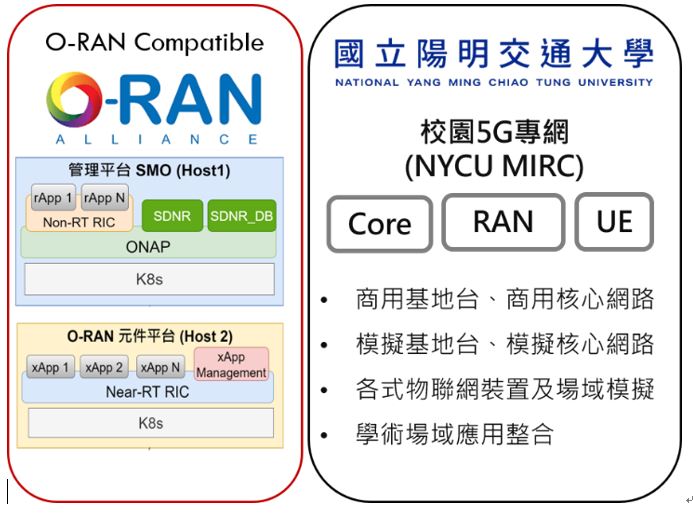
【UAV’s deployment and quantity optimization in 3D networks】
Problem Description
The current mobile communication system is easy to encounter coverage holes or inter-cell interference. Therefore, we introduce UAV as a air base station in 3D networks and propose deployment algorithm to improve overall coverage.
Key Technology
Centralized Deployment Algorithm:we collect network performance samples as training data and train a deep neural network as a surrogate function (black box). Then, we use zeroth-order optimization to solve UAV''''''''''''''''''''''''''''''''''''''''''''''''''''''''''''''''''''''''''''''''''''''''''''''''''''''''''''''''''''''''''''''''''''''''''''''''''''''''''''''''''''''''''''''''''''''''''''''''''''''''''''''''''''''''''''''''''''''''''''''''''''''''''''''''s deployment problem.
Contributions
-
Different from other technologies that consider simpler network scenarios, our technology will consider multiple UAVs, base stations and users at the same time, and explore the performance comparison of different user distributions.
-
Due to the use of surrogate function (black box), our algorithm is not limited to a specific network and can be applied to any complex network.

【Beam training scheme under UAV communication system】
Problem Description
We consider multiple UAVs under a centralized multi-beam base station architecture. We have designed an algorithm for maximizing system throughput by determining the optimal beamforming policy and optimal UAV position for millimeter-wave communication system.
Key Technology
Orthogonal Beamwidth Selection + Particle Swarm Optimization (UDOBS): First part of UDOBS uses the Ternary Search to find the upper bound of the beamwidth, and finds a set of beamwidth closest to the upper bound in the feasible region as the candidate solution. The second part of UDOBS employs the particle swarm optimization to acquire the optimal position of UAVs. Alternative optimization with iterative search is performed between two-phase UDOBS until convergence with the output of beamwidth and position of UAVs.
Contributions
-
The existing researches related to 3D network resource allocation are insufficient. Our design has considered comprehensive factors for the flight trajectory and beamforming configuration in a 3D network. The proposed UDOBS algorithm can improve the system sum rate by more than 50% compared with methods in open literature.
-
In multi-UAV scenario, the simulation result can reach about 7 Gbps of system sum rate.
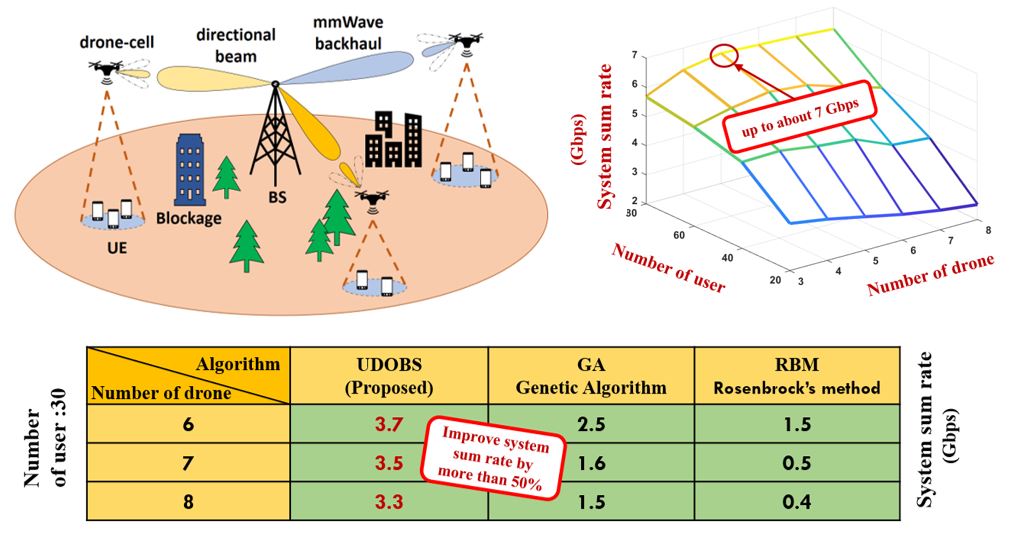
【3D Network Cooperative mmWave Beam Allocation】
Problem Description
Considering the network consists of multiple BSs* and multiple moving UAVs,designs algorithm for channel estimation and tracking to address fast variated system.
Key Technology
3D Cooperative Multiple BSs Multiple UAVs Tracking:Applying cooperative beam tracking with multiple BSs and particle filter.
Contributions
-
For 1-to-1 beam tracking, the case UAV moves in 120km/hr with PF* is finished and it finds similar MSE* to the performance of the case UAV moves in 36km/hr with KF* according to studies.
-
For 2-to-1 beam tracking , cooperative beam tracking with PF is finished.
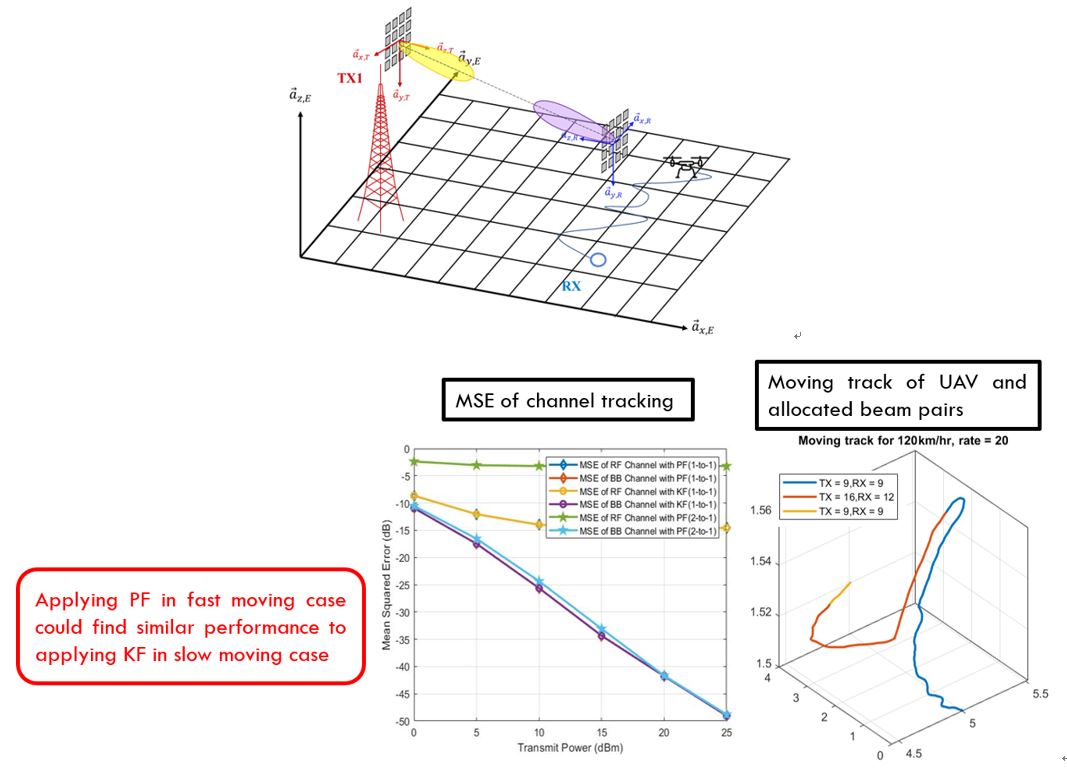
【Channel Estimation of UAV and Full-Duplex Beamforming for 3D Networks】
Problem Description
To achieve Holographic-Type Communication, we design channel estimation algorithm for UAV and hybrid beamforming algorithm for full-duplex communication for 3D networks.
Key Technology
Channel Estimation of UAV for 3D Network: We design an angle correcting algorithm for the LOS path and adopting ADMM algorithm for NLOS path with practical way of transmitting the training sequence. The obtained channel estimate has lower NMSE
Hybrid Beamforming Algorithm for Full-Duplex Communication:We design precoders and combiners to minimize the effect of self-interference while maintaining transmission quality under full-duplex millimeter wave communication
Contributions
-
Proposed a practical training procedure and an angle correcting channel estimation algorithm based on ADMM , accurately estimate the channel.
-
Taking advantage of the orthogonal matching pursuit algorithm to generate hybrid transceivers to reduce the hardware complexity of RF chains, the proposed algorithm is able to approach the ideal full-duplex
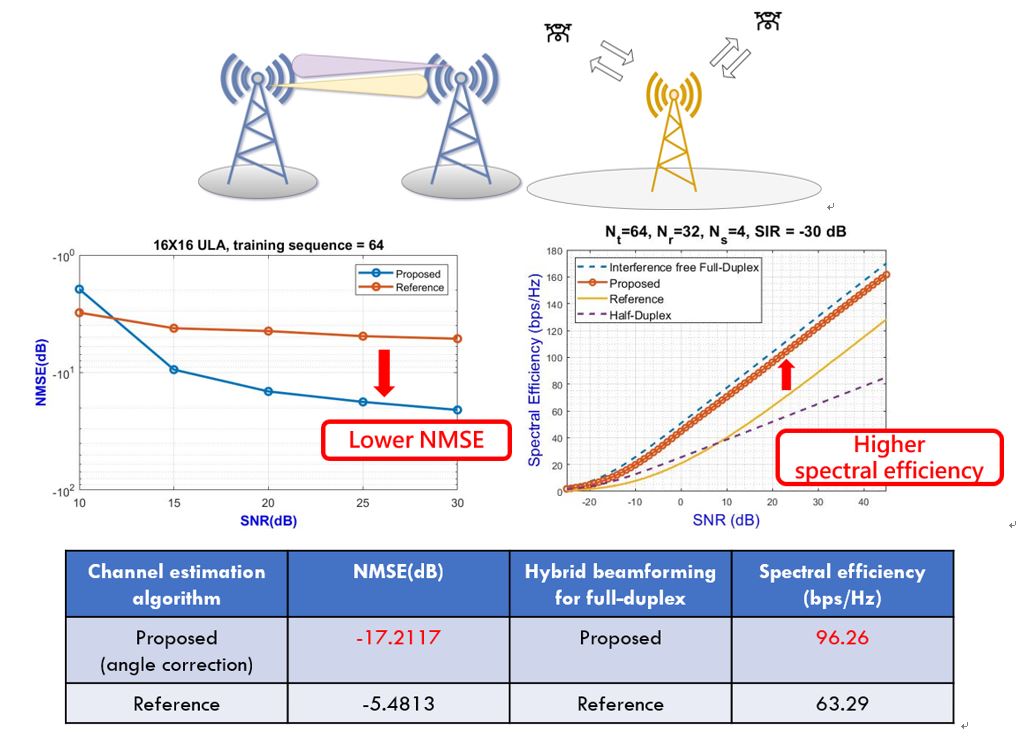
【3D networks joint optimization technology for caching and communication with UAVs】
Problem Description
Compared with the traditional 2D networks, 3D networks with UAVs acting as the base station can provide better channel conditions by avoiding obstacles. Here, to improve the network throughput, we consider both the power consumption and flight trajectory of UAVs and design the joint optimization for caching and communication.
Key Technology
BCD (Block Coordinate Descent) Algorithm: By decomposing the joint optimization problem into four sub-problems, namely the UAV trajectory, transmit power, user association and system bandwidth allocation problems, we proposed an iterative algorithm by using the block coordinate descent method.
Contributions
-
Unlike most literature that only considers a single UAV or single base station case when designing the joint optimization approach, our work considers multiple UAVs with multiple base stations in 3D networks for designing the optimization approach.
-
Unlike most literature that considers that UAVs can only move within the area of a single base station, our work allows UAVs to move between the areas of different base stations, which makes their trajectories more flexible.
Millimeter wave Large Tile-based Phased Antenna Array and RFIC
Introduction to techniques:
By integration between Ka-band 8x8 tile-based antenna array and 4x4 RFICs, many innovative technologies have been developed: (1) integration miniaturization of high density modules, including antennas, RFICs and feeding networks; (2) low profile antennas; (3) low loss interconnection and (4) wideband antenna/array and RFICs. Nevertheless, some specific technologies have been proposed: (a) The proposed novel wideband ultra-thin magneto-electric dipole antenna has a leading advantage in thickness; (b) The proposed novel mmWave 3D double-curved air cavity patch antenna has a leading advantage in bandwidth; (c) A multi-function mmWave RFIC integration technology has been developed and reduces the cost of mmWave RFIC automatic test equipment (ATE) solutions and (d) A novel frequency reconfigurable switched-type phase shifter maintains low amplitude and low phase variations, which has a leading advantage in operation bandwidth.
The related innovative research results had won 2021 FUTEX Futuretech Award, MOST.
Applicability of techniques to industry:
-
A multi-function mmWave RFIC integration technology has been developed and reduces the cost of mmWave RFIC automatic test equipment solutions. This joint project has been funded with 4,400,000 NTD by the MOST.
-
This project has successfully developed a wideband tile-based phased array antenna. We currently work with ITRI to jointly develop a solution of satellite payload antenna array with a funding size of 1,400,000 NTD.
-
A novel mmWave 3D double-curved air cavity patch antenna has been realized through an industry-academic joint project with PCB manufacturer.
-
Developed RFICs of CMOS Ku-Ka Band wideband up/down converter and phase shifter, and will carry out technology transfer with a company. Currently, the contract is being signed, and the amount is expected to reach several millions NTD.
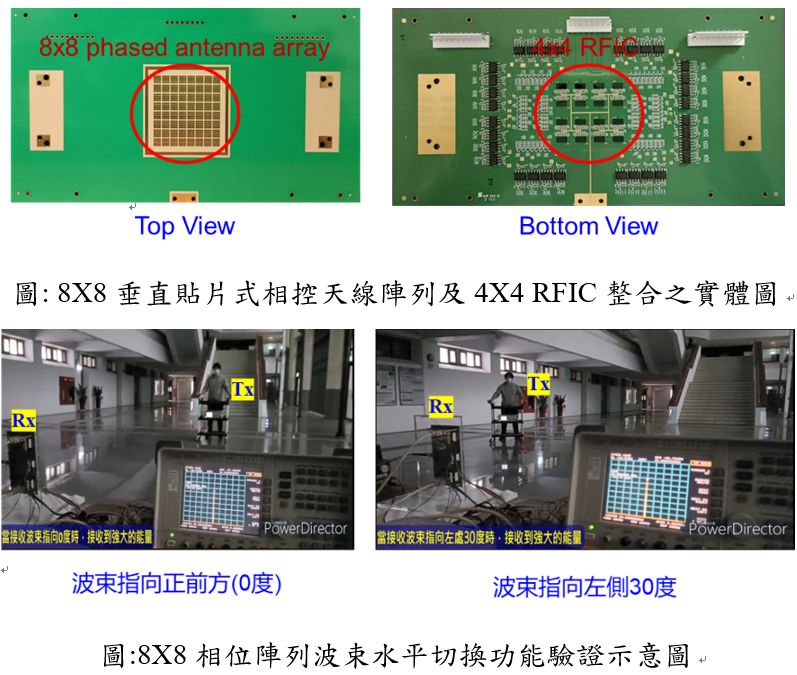
Solution to Ka band vertical patches with 4*4 phase-controlled antenna array and wide band RFICs
Ka band RFICs
Antenna in a Multilayer PCB (Antenna-in-Package)